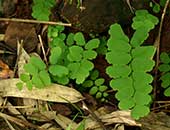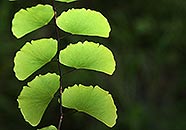Adiantum lunulatum Burm.f.
Synonyms |
Adiantum philippense L. |
|---|---|
Common name |
Walking maidenhair fern, or black maidenhair |
Description |
Rhizome short, suberect or creeping; rhizome scales tapering from the base to a sharp tip, c.3 mm long, dark brown. Fronds monomorphic, tufted, herbaceous, arching. Stipe up to 20 cm long, dark brown to black-purple, shiny, glabrous. Lamina pinnate, linear to lanceolate in outline, 36 × 11 cm, excluding a glabrous extension of the rhachis of varying length, which often ends in a proliferous bud or lamina with a terminal pinna; pinnae numerous (up to 15 pairs), persistent, petiolate, alternate, lunulate in outline, 25-50 × 10-25 mm, reduced in size towards the apex, the midrib forms the lower margin, outer margin irregurly incised into broad lobes; rhachis, pinna-stalklets dark brown to black-purple, hairless; pinna-stalklets 0.2-2.5 (-4) cm long, delicate, those of the lower pinnae longer. Sori elongate on apices of the pinna lobes, indusial flap linear to shallowly lunate, 0.4-2.5 cm wide, hairless. |
Notes | A. lunulatum is pinnate, has a rhachis that is not hairy and long petiolules. It resembles and A. mendoncae, which has more triangular pinnae with sharply toothed margin. A. soboliferum has a stipe and rhachis that are winged. |
Derivation | lunulatum: moon-shaped; referring to the half-moon shape of the pinnae. |
Habitat | On streambanks in riverine forest, in evergreen forest and in deciduous woodland. |
Distribution worldwide | Pantropical and subtropical. |
Distribution in Africa |
Angola, Benin, Burkina Fasso, Burundi, Cameroon, Central African Republic, Chad, Congo, Dem. Republic of Congo, Equatorial Guinea (incl. Bioko), Ethiopia, Ghana, Guinea, Guinea Bissau, Ivory Coast, Kenya, Liberia, Malawi, Mali, Mozambique, Niger, Nigeria, Senegal, Sierra Leone, South Africa, Sudan and South Sudan, Tanzania , Uganda, Zambia, Zimbabwe. |
Growth form |
Epiphytic, lithophytic, terrestrial. |
Literature |
|



